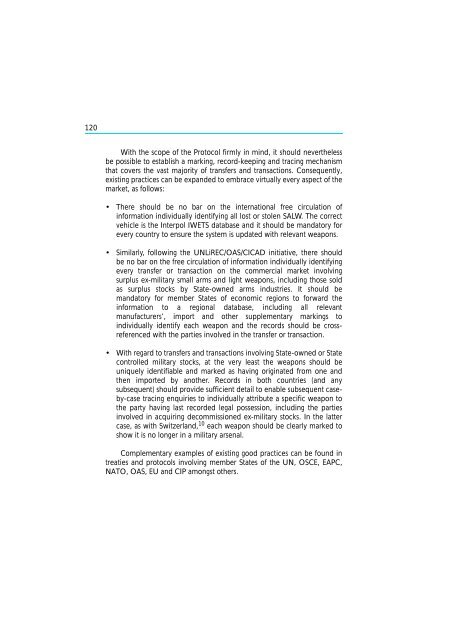The Scope and Implications of a Tracing Mechanism for Small Arms ...
The Scope and Implications of a Tracing Mechanism for Small Arms ...
The Scope and Implications of a Tracing Mechanism for Small Arms ...
You also want an ePaper? Increase the reach of your titles
YUMPU automatically turns print PDFs into web optimized ePapers that Google loves.
120<br />
With the scope <strong>of</strong> the Protocol firmly in mind, it should nevertheless<br />
be possible to establish a marking, record-keeping <strong>and</strong> tracing mechanism<br />
that covers the vast majority <strong>of</strong> transfers <strong>and</strong> transactions. Consequently,<br />
existing practices can be exp<strong>and</strong>ed to embrace virtually every aspect <strong>of</strong> the<br />
market, as follows:<br />
• <strong>The</strong>re should be no bar on the international free circulation <strong>of</strong><br />
in<strong>for</strong>mation individually identifying all lost or stolen SALW. <strong>The</strong> correct<br />
vehicle is the Interpol IWETS database <strong>and</strong> it should be m<strong>and</strong>atory <strong>for</strong><br />
every country to ensure the system is updated with relevant weapons.<br />
• Similarly, following the UNLiREC/OAS/CICAD initiative, there should<br />
be no bar on the free circulation <strong>of</strong> in<strong>for</strong>mation individually identifying<br />
every transfer or transaction on the commercial market involving<br />
surplus ex-military small arms <strong>and</strong> light weapons, including those sold<br />
as surplus stocks by State-owned arms industries. It should be<br />
m<strong>and</strong>atory <strong>for</strong> member States <strong>of</strong> economic regions to <strong>for</strong>ward the<br />
in<strong>for</strong>mation to a regional database, including all relevant<br />
manufacturers’, import <strong>and</strong> other supplementary markings to<br />
individually identify each weapon <strong>and</strong> the records should be crossreferenced<br />
with the parties involved in the transfer or transaction.<br />
• With regard to transfers <strong>and</strong> transactions involving State-owned or State<br />
controlled military stocks, at the very least the weapons should be<br />
uniquely identifiable <strong>and</strong> marked as having originated from one <strong>and</strong><br />
then imported by another. Records in both countries (<strong>and</strong> any<br />
subsequent) should provide sufficient detail to enable subsequent caseby-case<br />
tracing enquiries to individually attribute a specific weapon to<br />
the party having last recorded legal possession, including the parties<br />
involved in acquiring decommissioned ex-military stocks. In the latter<br />
case, as with Switzerl<strong>and</strong>, 10 each weapon should be clearly marked to<br />
show it is no longer in a military arsenal.<br />
Complementary examples <strong>of</strong> existing good practices can be found in<br />
treaties <strong>and</strong> protocols involving member States <strong>of</strong> the UN, OSCE, EAPC,<br />
NATO, OAS, EU <strong>and</strong> CIP amongst others.
















